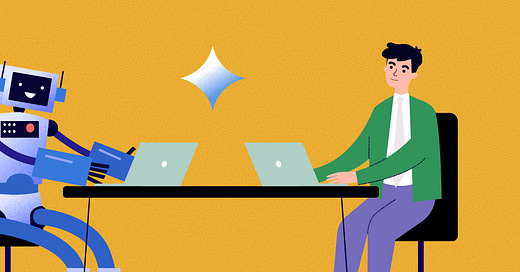How designers can leverage AI to become unstoppable
The future of AI and Design or how I think AI won't replace designers.
A Conversation Designers Need to Have
Over the past few weeks, I’ve been talking to designers about how they’re thinking about AI.
Some are curious.
Some are skeptical.
Many quietly wonder: Is my job at risk?
Most are underestimating the impact.
So I decided to write this, not as a prediction of doom, but as a rallying cry. Because I believe AI isn’t here to replace designers. It’s here to elevate them.
Design at a Crossroads
There’s a split happening in the design world.
On one side, designers dismiss AI as a gimmick or a threat.
On the other, a new wave is emerging, experimenting, adapting, and building faster than ever.
The Duolingo CEO recently compared the AI shift to the mobile-first revolution.
I’d go even further: this feels like the early web era all over again — when static HTML sites were swept away by drag-and-drop tools like Squarespace and Wix.
The tools got faster. The barriers got lower.
But great design still won.
That’s what’s happening again now.
Only this time, the acceleration is even faster.
Designers Are Uniquely Positioned to Win
Here’s what I believe: AI unlocks a new level of autonomy for designers.
Before designers were been either dependent on engineers or had to learn to code to bring ideas to life. We had to reply on business stakeholders to translate their vision into outcomes. That’s changing.
AI helps designers fill the gaps they often struggle with:
On the technical side: tools like Vercel’s v0 make it easy to build real, interactive prototypes. 10x faster than doing it in Figma’s prototyping tool.
On the business side: ChatGPT can help craft compelling narratives, calculate impact, and communicate value in economic terms.
This means designers can go from idea to insight to prototype, independently.
Less waiting. Less handoff. More impact.
It’s empowering and potentially transformative.
Designers are no longer confined to their silo. They can own more of the product process, shape more of the strategy, and even start their own businesses.
In a world where anyone can create with AI, it’s the designers who know how to frame problems, craft delightful experiences, and ship who will stand out.
As Dylan Field, CEO of Figma, put it:
“Design is becoming more essential in world with AI and more powerful. It’s craft, quality and point of view that makes a product stand out and be loved.”
In a world of infinite content, taste and perspective are what make products lovable.
How AI Is Already Changing the Way We Design
We’ve been integrating AI into our workflow and it’s a game-changer.
Here’s how:
Faster prototyping: Tools like Lovable and Vercel’s v0 let us turn designs into interactive prototypes with just a few prompts.
Smarter presentations: ChatGPT helps shape product narratives and write copy that resonates.
Data without blockers: AI helps us write queries, find insights, and back design decisions with real evidence.
What used to be slow and manual now takes minutes.
Designers no longer need to wait. They can just build.
What Happens Next and Why It Matters
If you’re a designer, this is your moment.
You don’t need to become a prompt engineer or abandon your craft. But you do need to engage with the shift. The best designers will treat AI as a creative partner — a way to unlock momentum, not compromise on quality.
The future won’t be designed by AI.
It will be designed with AI, by people who know how to shape it.
So lean in. Experiment. Sharpen your taste.
Because the designers who embrace this moment?
They’ll be the ones building the future.
So how are you using AI in your design workflow? Or are you still on the fence? Leave a comment below!





